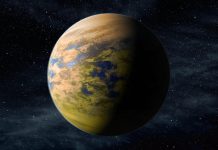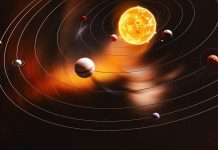
Imagine a weather report not from Earth, but from a strange, lonely world drifting through space without a star to orbit.
That is what astronomers from Trinity College Dublin have delivered, thanks to the powerful James Webb Space Telescope (JWST).
Their subject was SIMP-0136, a nearby rogue planet that shows spectacular auroral activity—light displays similar to the Northern Lights on Earth or the intense auroras seen on Jupiter.
SIMP-0136 is no ordinary world. Unlike planets in our solar system that circle the Sun, this “free-floating” planet travels through space untethered.
It is also scorching hot, with surface temperatures reaching around 1,500 °C—making even the hottest summer on Earth seem tame.
The research team used JWST’s extraordinary sensitivity to track tiny changes in the planet’s brightness as it rotated.
These changes revealed a wealth of information about its atmosphere, including its temperature, chemical makeup, and even signs of storm-like activity. For the first time, scientists were able to directly measure changes in the atmospheric properties of such an object.
Dr. Evert Nasedkin, the lead author of the study published in Astronomy & Astrophysics, explained: “These are some of the most precise measurements of the atmosphere of any extra-solar object to date.
The precise observations we made meant we could record temperature changes smaller than 5 °C. These changes were linked to shifts in the chemical composition of the planet’s atmosphere, which suggests that enormous storms—perhaps similar to Jupiter’s Great Red Spot—are rotating into view.”
But while the temperature and chemistry showed variation, another surprise came from the planet’s clouds. On Earth, clouds change constantly, with patches of clear sky appearing and disappearing. SIMP-0136, however, showed almost no variability in cloud cover.
Its clouds seem stable across the planet. These clouds are not made of water vapor, like ours, but of silicate grains—essentially tiny particles of sand suspended in the hot atmosphere.
One of the most striking discoveries was SIMP-0136’s auroral activity. Just like Earth’s Northern Lights, these glowing displays occur when charged particles interact with a planet’s magnetic field and atmosphere. On SIMP-0136, the auroras are so powerful that they heat its upper atmosphere, a process similar to what happens on Jupiter but on an even more intense scale.
This study is the first publication from Trinity’s new research group “Exo-Aimsir,” led by Professor Johanna Vos. The group includes contributions from postdoctoral fellows and Ph.D. candidates working together to explore weather beyond our solar system.
Their work builds on earlier studies by a team at Boston University but goes further, revealing more detail about the atmosphere using advanced analysis.
The team explained that different wavelengths of light reveal different features of the atmosphere, much like how changes in color across Earth’s sky can tell us about clouds and air conditions.
By combining these color changes with sophisticated models, the researchers were able to map the planet’s temperature, chemistry, and cloud structure.
Professor Vos noted: “This work is exciting because it shows that by applying state-of-the-art modeling techniques to the incredible data from JWST, we can start to piece together how weather works on worlds beyond our solar system. Understanding these processes will be essential as we continue to study exoplanets in greater detail.”
While current observations are mostly limited to brown dwarfs and isolated rogue planets like SIMP-0136, the future looks bright. Upcoming observatories such as the Extremely Large Telescope and NASA’s planned Habitable Worlds Observatory will make it possible to study the weather on planets ranging from giant gas worlds to rocky Earth-like ones.
For now, SIMP-0136 gives us a tantalizing glimpse of the alien weather patterns unfolding on worlds drifting alone in the darkness—lit by their own glowing auroras.
Source: Trinity College Dublin.



